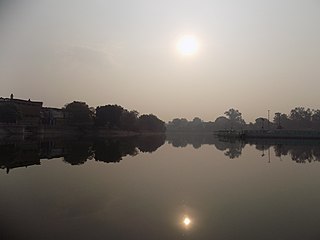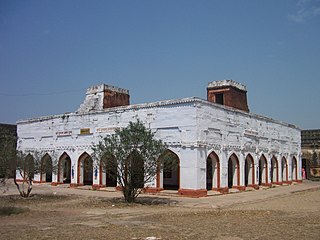
Bundeli or Bundelkhandi is an Indo-Aryan language spoken in the Bundelkhand region of central India. It belongs to the Central Indo-Aryan languages and is part of the Western Hindi subgroup.
Rajput, also called Thakur, is a large multi-component cluster of castes, kin bodies, and local groups, sharing social status and ideology of genealogical descent originating from the Indian subcontinent. The term Rajput covers various patrilineal clans historically associated with warriorhood: several clans claim Rajput status, although not all claims are universally accepted. According to modern scholars, almost all Rajput clans originated from peasant or pastoral communities.
Mahoba is a city in Mahoba District of the Indian state of Uttar Pradesh in the Bundelkhand region, well known for the ninth century granite Sun temple built in Pratihara style. It is also well known for the 24 rock-cut Jain tirthankara image on Gokhar hill. Mahoba is known for its closeness to Khajuraho, Lavkushnagar and other historic places like Kulpahar, Charkhari, Kalinjar, Orchha, and Jhansi. The town is connected with railways and state highways.

Prithviraja III, popularly known as Prithviraj Chauhan or Rai Pithora, was a king from the Chauhan (Chahamana) dynasty who ruled the territory of Sapadalaksha, with his capital at Ajmer in present-day Rajasthan in north-western India. Ascending the throne as a minor in 1177 CE, Prithviraj inherited a kingdom which stretched from Thanesar in the north to Jahazpur (Mewar) in the south, which he aimed to expand by military actions against neighbouring kingdoms, most notably defeating the Chandelas.

The Chandelas of Jejakabhukti was an Indian dynasty in Central India. The Chandelas ruled much of the Bundelkhand region between the 9th and the 13th centuries. They belonged to the Chandel clan of the Rajputs.
The Dhangars are a herding caste of people found in the Indian states of Maharashtra, Karnataka, Goa, Madhya Pradesh and Uttar Pradesh. They are referred to as Gavli in southern Maharashtra, Goa and northern Karnataka, Golla in Andhra Pradesh and Karnataka and Ahir in northern Maharashtra. Some Gavlis live in forested hill tracts of India's Western Ghats. Gavli, also known as Dange or Mhaske, and Ahir are a sub-caste of Dhangar. However, there are many distinct Gavli castes in Maharashtra and Dhangar Gavli is one of them.

Mahoba district is a district of the Indian state of Uttar Pradesh. Headquartered in the city of Mahoba, the district had a population of a population of 875,958 as of the 2011 Indian census and occupies 2884 km2 within the Chitrakoot division of Uttar Pradesh. As of 2011 it was the least populous district of Uttar Pradesh. Mahoba District is also known as Alha-Udal Nagari.

Orai is a city in Uttar Pradesh, India, and the administrative headquarters of Jalaun District. All administrative offices of Jalaun District, including the District Collectorate, police, telecom and various other government organizations are located in this city. In 2019, Orai received the award of 'Fastest Mover' Small City among India under Swachh Survekshan, an annual cleanliness survey carried by the Quality Council of India.
Banaphar, also spelled Banafar and Banafer, is a clan native to the Indian subcontinent of mixed Ahir and Rajput descent.
Ahir or Aheer are a community of traditionally non-elite pastoralists in India, most members of which identify as being of the Indian Yadav community because they consider the two terms to be synonymous. The Ahirs are variously described as a caste, a clan, a community, a race and a tribe.
Alha was a legendary general of the Chandel king Paramardideva, who fought Prithviraj Chauhan in 1182 CE. He is one of the main characters of the Alha-Khand ballad.

The term Alha Khand is used to refer to poetic works in Hindi which consists of a number of ballads describing the brave acts of two 12th century Banaphar Ahir heroes, Alha and Udal, generals working for king Paramardi-Deva (Parmal) of Mahoba against Prithviraj Chauhan of Ajmer. The works has been entirely handed down by oral tradition and presently exists in many recensions, which differ from one another both in language and subject matter. The Bundeli, Bagheli, Awadhi, Bhojpuri, Maithili, and Kannauji recensions are the most well known among these.
Yadav, Jadam, or Jadav refers to a grouping of traditionally non-elite, peasant-pastoral communities or castes in India that since the 19th and 20th centuries have claimed descent from the legendary king Yadu as a part of a movement of social and political resurgence. The term Yadav now covers many traditional peasant-pastoral castes such as Ahirs of the Hindi belt and the Gavli of Maharashtra.
The Banaut is a Bundela Rajput clan found in the Indian states of Bihar and Jharkhand. Their loved ones called them banaut which means who meditate and save Ban (forest). They are said to have left Orchha, Jhansi, Mahoba and other parts of Bundelkhand during Mughal period and migrated to Bihar and Jharkhand.
Veer Lorik is part of the Bhojpuri folklore of Bihar and eastern Uttar Pradesh, India. According to S.M. Pandey, it is considered to be the Ramayana by the Ahir. Veer Lorik is a divine character of the legend of the Ahir of eastern Uttar Pradesh. The Veer Lorik Stone on the banks of the Son River in the Sonbhadra, Uttar Pradesh, contains a love story. He is sometimes known as the Lorikayan, after the folkloric tale of that name.

Dinman Hardoul Singh or Lala Hardoul is a Hindu folk deity of Bundelkhand in India. He was the prince of Orchha and the son of maharaja Vir Singh Deo and the brother of Jhujhar Singh. He was born in 1664 and died in 1688 at the age of 24. A temple of Hardoul in Bundelkhand is a centre for pilgrims and according to local beliefs he is still alive and is worshipped as a deity.
Paramardi was a king of the Chandela dynasty of central India. He was the last powerful Chandela king, and ruled the Jejakabhukti region. Around 1182–83 CE, he was defeated by Prithviraj Chauhan, who raided the Chandela capital Mahoba. Paramardi managed to recover the Chandela power over the next few years, but was defeated by the Ghurid general Qutb ud-Din Aibak around 1202–03 CE.
Modern historians agree that Rajputs consisted of a mix of various different social groups and different varnas. Rajputisation explains the process by which such diverse communities coalesced into the Rajput community.

Khet Singh Khangar was one of the rulers of Garh Kundar.
Naiki Devi was the regent queen of Chaulukya dynasty during her son Mularaja II's infancy from 1175. She was a queen of the Chaulukya king Ajayapala.








